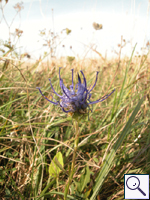|
||||||
|
PHYTEUMA. Rampions. [Campanulaceae] |
|
|
Four species of Phyteuma are recorded in Britain. These include the native Round-headed Rampion (P. orbiculare) and Spiked Rampion (P. spicatum). Spiked Rampion (P. spicatum) is protected under Schedule 8 of the Wildlife and Countryside Act, 1981. Five British miners are recorded on Phyteuma. A key to the European miners recorded on Phyteuma is provided in Bladmineerders van Europa. |
|
Key for the identification of the known mines of British |
1a > Stem miner: An external stem mine with frass in two rows of disconnected strips. Pupation in stem at end of mine (Spencer, 1972b: 25; Spencer, 1976: 61 (fig. 63B), 65-6). |
|
Ophiomyia heringi Stary, 1930 [Diptera: Agromyzidae]. |
1b > Leaf-miner |
2a > Leaf-miner: A distinctive mine primarily above mid-rib, with irregular short lateral offshoots into leaf blade. Pupation external (Spencer, 1972: 51 (fig. 172), 55; Spencer, 1976: 270, 271 (fig. 486)). Branched, whitish, upper-surface corridor; main axis overlying the midrib; side branches overlying the main lateral veins. (In Campanula and Phyteuma the mine is much less branched, sometimes nothing more than a corridor on top of the midrib). Frass in rather long strings. Usually the mines begins as a long and narrow, shallow, tortuous lower-surface corridor that ends upon the midrib but otherwise is not associated with the leaf venation. Often this initial corridor is filled with callus, and then even less conspicuous. Pupation outside the mine. A linear mine on the upper surface, usually following the midrib and showing side branches along the veins. The frass is in strings. |
|
Liriomyza strigata (Meigen, 1830) [Diptera: Agromyzidae]. |
2b > Leaf-miner: Mine not primarily above mid-rib. |
3a > Leaf-miner: A shallow whitish linear-blotch mine. Puparium yellowish brown; outside the mine |
|
Amauromyza gyrans (Fallén, 1823) [Diptera: Agromyzidae]. |
| 3b > Leaf-miner: An irregular whitish linear mine which can broaden at end and become blotch-like (Spencer, 1976: 397). |
|
| Phytomyza campanulae Hendel, 1920 [Diptera: Agromyzidae]. |
| 3c > Leaf-miner: Very long, rather deep corridor, initially lower-surface, later upper-surface. In smaller leaves almost always a secondary blotch originates, that can occupy the entire leaf. Frass initially in pearl strings, later in scattered aggregations. Pupation outside the mine; exit slit in upper epidermis. |
|
Phytomyza rapunculi Hendel, 1927 [Diptera: Agromyzidae] |
| Last updated 06-Jul-2019 Brian Pitkin | ||

